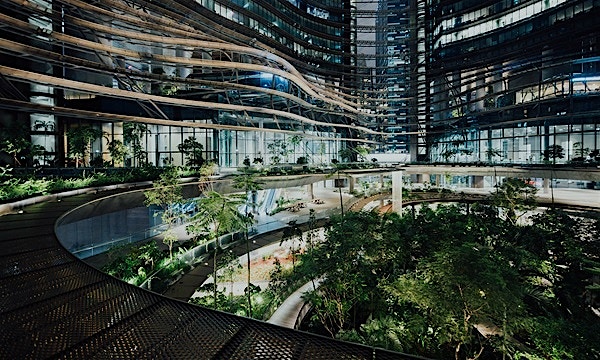As new-age enterprises witness a shift toward purpose-based buying by consumers, it’s important for technology to remain aligned to sustainable business behaviors.
Tech2Sustain—a platform established to promote conversations for a greener tomorrow—seeks to share insights about the topic, as industry peers come together to share their knowledge, ideas and experiences. Prominent industry leaders meet periodically on this collaborative platform to share their insights and learnings around the role of technology in driving sustainable consumerism.
In Session 3, Santhosh Jayaram, Senior Vice President & Global Head – Sustainability at HCLTech, interacts with five industry leaders on how the role of technology is swiftly driving sustainable consumerism and how the strategic decisions of the right technology adoption are playing a catalytic role in addressing the buying behaviors of the consumers.
The attending industry thought leaders believe sustainability is a compelling business lever to help navigate a changing dynamic industry ecosystem. Sustainability calls for everything in an organization’s purpose, core values and technological innovation.
The real driving force fostering sustainable technology-driven business models
In the retail industry, influencing and instilling sustainability on both sides—the producers and the consumers—is vital.
“Retailers play a very pivotal role in sustainable supply chain management, which contains multiple facets. First, is in supply chain productivity and the net end-to-end economic benefits that each of the players in the supply chain can achieve. Second, is the social worker welfare, including the employees, the laborers and everyone involved across the supply chain. And the third, the environmental hazards or human environmental impact. Sustainable supply chain management is about doing good with all three of these links,” said Suyog Barve, Technology Fellow & Senior Director at Macy’s.
“Two terminologies are most beneficial here: Three Rs (reduce, reuse and recycle) and five Ps (product, packaging, price, place and promotion). So, if a retailer follows this, it can build a sustainable supply chain,” he added.
The three Rs and the five Ps act as catalyst in meeting the sustainability goals of the supply chain, ensuring the ethical sourcing of goods and materials.
According to Jayaram, in the coming years technology will play a bigger role in ensuring consumers can identify the exact origin of a product and its net carbon footprint.
This is where the driving forces come into the picture that are shaping sustainable business models’ adoption of technology.
“From the earliest days of the pandemic, consumers around the world said that they planned to make more sustainable choices about how they spend their time and their money. Many people are willing to pay more for products and services that reflect their specific agendas. So, we found consulting data and preliminary research in this domain that shows consumers are looking beyond the brand to consider this sustainability event, an organization’s full value chain. And we think this opens the doors for many companies to create products or solutions that reflect the nuanced concerns of their target customers. The demand is not only there with millennials [yet], but we expect it to grow exponentially over the coming generations,” said Shevy Magen, Corporate Innovation Leader & Partner - Digital Re-Invention, Avasant.
However, it should be noted that during this decade, money will start changing hands to the millennials and they will become some of the most powerful decision-makers.
“For systems integrators and technology and sustainability leaders, like HCLTech, our recommendation would be to continue creating space between you and your competition by broadcasting loud and wide your investments in areas of sustainability to create value-based consumption models, as a long-term ecosystem partner to your clients,” he added.
At HCLTech, the long and rich history of giving back to communities was built on the values of innovation, entrepreneurship, humanity and a people-centric culture. Besides incorporating the right environmental, social and governance (ESG) practices to ensure a sustainable present and future, HCLTech’s holistic approach is designed to maximize its contribution towards the UN Sustainable Development Goals (SDGs), where the vision for sustainability is based on three guiding principles: Act, Pact and Impact.
Energy consumption as an indicator of sustainability
From the retail sector influencing its customers with green practices to how millennial consumers are driving some of these changes around sustainability and how data and analytics plays a critical role in the whole of tech enablement toward sustainability, the conversation turned to how the wines and spirits industry looks at enabling technologies around sustainability and can positively impact energy consumption, while ensuring that the source of energy is green.
“Energy consumption is an important part of the decision for leaders right now. However, when it comes to the wine and spirits industry; aging, storage, transit and vinyl products are some of the major factors. While beverages like wine and beer impose temperature constraints, others are sensitive to light and failing to meet these conditions may result in delivery of unsafe products to the consumers. So, energy is needed when it comes to refrigeration or temperature control of the basket. The industry itself, from warehouses and production facilities, are deploying environmental-monitoring systems and patching them up with the building management platforms to get a more holistic picture,” said Phani Gadiraju, Technology Leader - Warehouse & Supply Chain, Southern Glazer’s Wine & Spirits.
“Energy cost optimization is a key aspect of reducing the footprint of energy consumption. And some technologies have proved to be quite effective, such as automated light switching, temperature control, temperature and storage and distribution facilities. Also, IoT is proving useful as it’s connecting and remotely controlling previously unconnected things. In addition, organizations are looking to use electric vehicles in their fleet vision and last mile delivery to further reduce our carbon footprint,” he added.
An economic benefit
Moving onto the next segment, the discussion moved to how sustainability is impacting administration and management in the hospitality and entertainment sector. From having unique sustainability models, what are the changes sustainability has brought in this hospitality sector?
“Sustainability is both a social, environmental and economic concept with a significant eye on optimization. Focusing on cost reduction is a benefit even when you’re focused on environmental impact reduction. People try and separate cost reduction and benefits associated with that and perceive the inclusion of environment always adds to costs. But that’s not true. There are lots of aspects of sustainability, environmental and social that result in both optimizations: operationally and economically. So, a shift in thought process—from just procuring energy and paying for it and not really thinking about it—made us instead focus on our energy mix. This consists of various phases like where is this energy being used, using data to understand where energy is being used, where it is being wasted and how to make energy conservation and take costs out of the system,” said Yalmaz Siddiqui, Vice President - Corporate Sustainability, MGM Resorts International.
Service providers can embed sustainability to this next level, where costs can be reduced in line with environmental goals.
Be smart when it comes to sustainability in manufacturing
“Smart manufacturing and digital twin are examples of simulation-based design validation, which eliminates the need of multiple material prototypes and wastage, resulting in improved time-to-market. This helps companies launch their products faster, cheaper and be more competitive in the market. Smart labeling and using biodegradable packaging is another sustainability lever. We saw Pepsi and some others do it. Such solutions not only provide more information to the end consumer, but it also results in less supplies to be used for packaging and labeling. The smart use of technology in the form of temperature indicators is an additional lever. As the current temperature deviates from the recommended storage the color changes, which helps alert any temperature changes in line with the expected shelf life of the product,” said Vijay Verma, Executive Vice President, Retail & CPG, HCLTech.
Initiatives by companies toward sustainability for their consumers
After having looked at how the retail, beverage, hospitality and manufacturing industry are adopting sustainability practices with tech innovations helping them in the journey, the leaders explored how customers are driving the changes in their business models.
“Customers and consumers and their participation is so vital in closing the sustainability loop. According to 2019 research, 65% of customers know about what sustainability is, but they do not have enough motivation to invest; 31% customers have the motivation, but they lack the ability to participate because there is not enough infrastructure available; and 27% customers don’t even know what sustainability is. Retail companies have an important part to play in all these three areas by creating avenues for the customers so that they understand what sustainable products are,” said Barve.
“Second is greenwashing where misleading facts are presented to claim investment in sustainability. Therefore, it’s important to create avenues for the customers to not only understand what they’re buying, but even after the sales, they need to understand how they can make the best out of the product, how can they return the packaging or how can they return an empty bottle to get a discounted refill. Retailers need to invest in creating avenues, it’s like a partnership between the consumer and the supplier to build that whole ecosystem where information is not only available but easy to understand and consume. That’s how you really fill the gap between that intention and action,” added Barve.
Reverse logistics plays an important part of the strategy of many of the firms. However, in the luxury entertainment industry, customers play slightly different roles. Let’s look at the inspiration and influence MGM gets from the customers and its own way of thinking.
“There’s a customer voice but at any company, including ours, we do things that are self-driven. From an environmental sustainability standpoint, the greener the businesses, the better it is. For someone like MGM and many more organizations, it’s the B2B customers who have more influence, because they can bring social environmental criteria concretely into their contracts and their agreements within their supply chain. And then we have investors who are deeply interested in ESG, because they know that external factors are significantly material to a company. And this is what’s driving the demand for good data and a good performance record to reflect on the investors’ books,” added Siddiqui.
Companies turning to their partners to integrate sustainability
The right technology partner is essential in helping any organization meet their sustainability goals.
“Technology is easily replicable, but core culture can’t be. After having come together in a partnership model or outcome-based business models, how much can you achieve, can we help in meeting the goals which the clients have defined? To do that, you need a trusted partner who is transparent, flexible and believes in ideapreneurship. We are seeing a lot of changes happening in the last two years, with things moving quickly in the entire cloud journey for the retailers and CPG companies. So, you need partners who can bring in thought leadership and ideas. It’s not only technology but the long-trusted partnership based on flexibility, transparency and ideapreneurship,” said Verma.
Magen echoed Verma’s thoughts, adding: “For companies like HCLTech, when you compete for some of the largest transformational deals in the marketplace, your deal teams need to continue to influence the influencers in the evaluation process, whether it is sole-sourced or working with third party advisors like Amazon. I think this drumbeat of consistent messaging will really resonate with the millennial decision-makers and buyers as they grow old, for the consumer brands and the retail industry ecosystems.”





